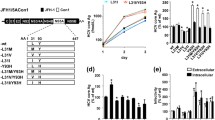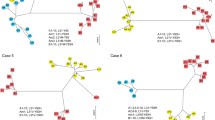Abstract
Background
The emergence of a deletion mutant at hepatitis C virus (HCV) NS5A-P32 (P32del) has recently been reported in a subset of chronic hepatitis C patients who experience virologic failure after direct-acting antiviral drug (DAA) treatment. This mutation confers extremely high resistance to NS5A inhibitors. No effective treatment has been established for cases with this mutation.
Methods
We used a JFH1-based recombinant virus with NS5A from a genotype 1b strain to introduce a P32del mutation. We inoculated human hepatocyte chimeric mice with sera from a patient with ledipasvir/sofosbuvir therapy failure carrying a genotype 1b HCV with NS5A L31M and P32del or from a DAA-naïve patient carrying wild-type virus.
Results
JFH1-based chimeric viruses with P32del showed sufficient levels of replication for in vitro assay despite the suppression of viral growth and infectious virus production. Variants with P32del exhibited severe resistance to all tested NS5A inhibitors, including daclatasvir, ledipasvir, elbasvir and velpatasvir, but were as susceptible to NS3/4A inhibitors, NS5B inhibitors, interferon alfa-2b, and ribavirin as wild-type viruses in the in vitro assay. The P32del mutant virus caused persistent infection in all inoculated chimeric mice with high viral titer and frequency. The virus was resistant to the ledipasvir/GS-558093 (a nucleotide analog inhibitor of NS5B polymerase) regimen but susceptible to either simeprevir plus GS-558093 or peg-interferon alfa-2b, compared to the wild-type virus.
Conclusion
Therapies combining at least two drugs among NS3/4A inhibitors, NS5B inhibitors and non-selective antiviral agents may be effective for HCV-infected patients with NS5A-P32del.




Similar content being viewed by others
Abbreviations
- HCV:
-
Hepatitis C virus
- DAA:
-
Direct-acting antiviral drug
- RASs:
-
Resistance-associated substitutions
- VF:
-
Virologic failure
- P32del:
-
NS5A-P32 deletion mutant
- TK-NOG:
-
Thymidine kinase transgene
- SVR:
-
Sustained viral response
References
Mizokami M, Yokosuka O, Takehara T, et al. Ledipasvir and sofosbuvir fixed-dose combination with and without ribavirin for 12 weeks in treatment-naive and previously treated Japanese patients with genotype 1 hepatitis C: an open-label, randomised, phase 3 trial. Lancet Infect Dis. 2015;15:645–53.
Friborg J, Zhou N, Han Z, et al. In vitro assessment of re-treatment options for patients with hepatitis C virus genotype 1b infection resistant to daclatasvir plus asunaprevir. Infect Dis Ther. 2014;4:137–44.
Krishnan P, Schnell G, Tripathi R, et al. Integrated resistance analysis of CERTAIN-1 and CERTAIN-2 studies in Hepatitis C virus-infected patients receiving glecaprevir and pibrentasvir in Japan. Antimicrob Agents Chemother. 2018;62:e02217.
Kai Y, Hikita H, Morishita N, et al. Baseline quasispecies selection and novel mutations contribute to emerging resistance-associated substitutions in hepatitis C virus after direct-acting antiviral treatment. Sci Rep. 2017;7:41660.
Doi A, Hikita H, Sakamori R, et al. Nonstructural protein 5A/P32 deletion after failure of ledipasvir/sofosbuvir in hepatitis C virus genotype 1b infection. Hepatology. 2018;68:380–3.
Wang C, Sun JH, O’Boyle DR, et al. Persistence of resistant variants in hepatitis C virus-infected patients treated with the NS5A replication complex inhibitor daclatasvir. Antimicrob Agents Chemother. 2013;57:2054–65.
Akuta N, Sezaki H, Suzuki F, et al. Ledipasvir plus sofosbuvir as salvage therapy for HCV genotype 1 failures to prior NS5A inhibitors regimens. J Med Virol. 2017;89:1248–54.
Zhong J, Gastaminza P, Cheng G, et al. Robust hepatitis C virus infection in vitro. Proc Natl Acad Sci USA. 2005;102:9294–9.
Akazawa D, Date T, Morikawa K, et al. CD81 expression is important for the permissiveness of Huh7 cell clones for heterogeneous hepatitis C virus infection. J Virol. 2007;81:5036–45.
Okamoto Y, Masaki T, Murayama A, et al. Development of recombinant hepatitis C virus with NS5A from strains of genotypes 1 and 2. Biochem Biophys Res Commun. 2011;410:404–9.
Nitta S, Asahina Y, Matsuda M, et al. Effects of resistance-associated NS5A mutations in hepatitis C virus on viral production and susceptibility to antiviral reagents. Sci Rep. 2016;6:34652.
Wakita T, Pietschmann T, Kato T, et al. Production of infectious hepatitis C virus in tissue culture from a cloned viral genome. Nat Med. 2005;11:791–6.
Kato T, Date T, Murayama A, et al. Cell culture and infection system for hepatitis C virus. Nat Protoc. 2006;1:2334–9.
Murayama A, Sugiyama N, Watashi K, et al. Japanese reference panel of blood specimens for evaluation of hepatitis C virus RNA and core antigen quantitative assays. J Clin Microbiol. 2012;50:1943–9.
Momose H, Matsuoka S, Murayama A, et al. Evaluation of in vitro screening and diagnostic kits for hepatitis C virus infection. J Clin Virol. 2018;105:97–102.
Kato T, Choi Y, Elmowalid G, et al. Hepatitis C virus JFH-1 strain infection in chimpanzees is associated with low pathogenicity and emergence of an adaptive mutation. Hepatology. 2008;48:732–40.
Kai Y, Hikita H, Tatsumi T, et al. Emergence of hepatitis C virus NS5A L31V plus Y93H variant upon treatment failure of daclatasvir and asunaprevir is relatively resistant to ledipasvir and NS5B polymerase nucleotide inhibitor GS-558093 in human hepatocyte chimeric mice. J Gastroenterol. 2015;50:1145–51.
Lenz O, Verbinnen T, Lin TI, et al. In vitro resistance profile of the hepatitis C virus NS3/4A protease inhibitor TMC435. Antimicrob Agents Chemother. 2010;54:1878–87.
Hasegawa M, Kawai K, Mitsui T, et al. The reconstituted ‘humanized liver’ in TK-NOG mice is mature and functional. Biochem Biophys Res Commun. 2011;405:405–10.
Lam AM, Edwards TE, Mosley RT, et al. Molecular and structural basis for the roles of hepatitis C virus polymerase NS5B amino acids 15, 223, and 321 in viral replication and drug resistance. Antimicrob Agents Chemother. 2014;58:6861–9.
Chang W, Bao D, Chun BK, et al. Discovery of PSI-353661, a novel purine nucleotide prodrug for the treatment of HCV infection. ACS Med Chem Lett. 2011;2:130–5.
Lohmann V, Körner F, Koch J, et al. Replication of subgenomic hepatitis C virus RNAs in a hepatoma cell line. Science. 1999;285:110–3.
Teraoka Y, Uchida T, Imamura M, et al. Prevalence of NS5A resistance associated variants in NS5A inhibitor treatment failures and an effective treatment for NS5A-P32 deleted hepatitis C virus in humanized mice. Biochem Biophys Res Commun. 2018;500:152–7.
Panel AIHG. Hepatitis C guidance: AASLD-IDSA recommendations for testing, managing, and treating adults infected with hepatitis C virus. Hepatology. 2015;62:932–54.
Sarrazin C, Cooper CL, Manns MP, et al. No impact of resistance associated substitutions on the efficacy of Sofosbuvir, Velpatasvir, and Voxilaprevir for 12 Weeks in HCV DAA-experienced patients. J Hepatol. 2018;69(6):1221–30.
Bourlière M, Gordon SC, Flamm SL, et al. Sofosbuvir, Velpatasvir, and Voxilaprevir for previously treated HCV infection. N Engl J Med. 2017;376:2134–46.
Izumi N, Takehara T, Chayama K, et al. Sofosbuvir-velpatasvir plus ribavirin in Japanese patients with genotype 1 or 2 hepatitis C who failed direct-acting antivirals. Hepatol Int. 2018;12:356–67.
Acknowledgments
We would like to thank Gilead Sciences Inc. (Foster City, CA, USA) for providing ledipasvir and GS-558093. This work was partly supported by a Grant-in-Aid for Research on Hepatitis from the Japanese Agency for Medical Research and Development (JP18fk0210021, JP18fk0210002, JP18fk0210025), Ministry of Education, Culture, Sports, Science and Technology-Japan (JP16H05285), and Japan Society for the Promotion of Science (JP17K19647).
Disclosure
Dr. Tetsuo Takehara has received grants from Chugai Pharmaceutical Co. Ltd., Bristol-Myers Squibb, MSD K.K., AbbVie Inc. and Gilead Sciences. Dr. Tetsuo Takehara is on the speakers’ bureau for Bristol-Myers Squibb, MSD K.K., AbbVie Inc. and Gilead Sciences. Dr. Hayato Hikita has received grants from Bristol–Myers Squibb and MSD K.K. Dr. Ryotaro Sakamori and Dr. Tomohide Tatsumi have received grants from MSD K.K. Dr. Takahiro Kodama has received grants from MSD K.K. and Gilead Sciences. Dr. Yasuhiro Asahina belongs to a donation-funded department funded by Toray Industries Inc., Gilead Sciences, AbbVie GK, Chugai Pharmaceutical Co. Ltd., Fuji Rebio Inc., and Merck Sharp & Dohme.
Author information
Authors and Affiliations
Corresponding author
Additional information
Publisher's Note
Springer Nature remains neutral with regard to jurisdictional claims in published maps and institutional affiliations.
Electronic supplementary material
Below is the link to the electronic supplementary material.
535_2018_1541_MOESM1_ESM.pptx
Supplementary material 1. Susceptibility of JFH1/5ACon1-wt, JFH1/5ACon1 with P32del (P32del), and JFH1/5ACon1 with L31M-P32del (L31M+P32del). Huh7.5.1 cells were electroporated with in vitro-transcribed HCV RNA. Four hours after electroporation, the culture media were replaced with fresh media containing NS5A inhibitors (A), NS3/4A inhibitors (B), NS5B inhibitors (C), and other inhibitors (D). After incubation for 72 hours, the cells were harvested, and the intracellular HCV core Ag levels were measured. The data are presented as percentages of the DMSO-treated control. Black circles indicate the HCV core Ag levels in JFH/5ACon1-wt. Red squares indicate the HCV core Ag levels in P32del. Blue diamonds indicate the HCV core Ag levels in L31M+P32del.
Rights and permissions
About this article
Cite this article
Doi, A., Hikita, H., Kai, Y. et al. Combinations of two drugs among NS3/4A inhibitors, NS5B inhibitors and non-selective antiviral agents are effective for hepatitis C virus with NS5A-P32 deletion in humanized-liver mice. J Gastroenterol 54, 449–458 (2019). https://doi.org/10.1007/s00535-018-01541-x
Received:
Accepted:
Published:
Issue Date:
DOI: https://doi.org/10.1007/s00535-018-01541-x




